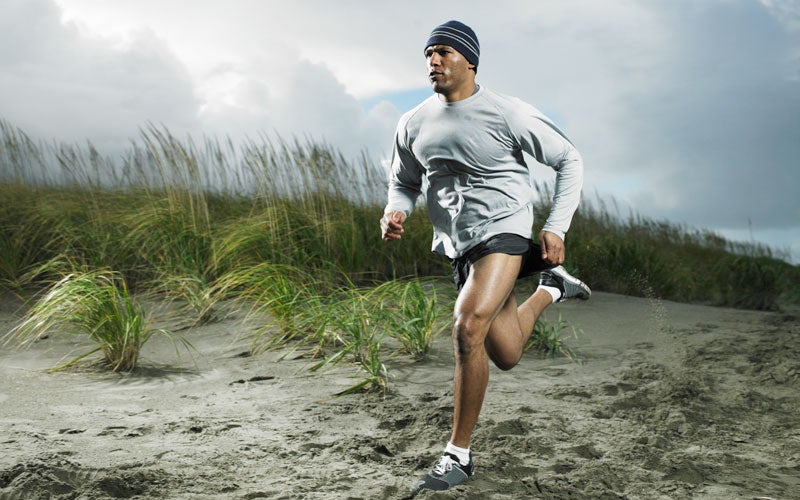New year; new you. From augmented-reality training to wearable technology, 2014 will be the year that science puts you at the top of your game. And these are the eight must-follow trends that will get you there.
8. Muscle Tracking
Until now, the only way to reliably measure muscle activity was through a in which a trained professional stuck electrodes that monitor muscles’ electrical signals to the skin. But Silicon Valley start-up figured out how to incorporate those sensorsÔÇösans adhesiveÔÇöinto stylish compression garments that also track heart and breathing rates. The result: smart training shirts and shorts that will highlight imbalances, improper posture, and over or under exerted muscles so you can optimize your workouts, and reduce your chance of injury. Coming this spring at a starting cost of about $300.
7. Bike Commuting Goes Mainstream
Prediction: cycling fashion, technology, and infrastructure will converge in 2014, making this the year of the bike. 
Let’s start with smartwheels. Two companies, and , plan to sell battery powered, smartphone-enabled rear bike wheels in 2014. The design makes it simple to turn most bikes into electric rigs, so commuting will be easier than ever. The price, however, may be too steep to start at $590 for FlyKly’s Smart Wheel, and $699 for Superpedestrian’s Copenhagen Wheel.
On the fashion front, cycling lifestyle brand saw sales in the first half of 2013, with no sign of slowing. And Swedish airbag helmet, the went on sale in late 2013, promising to end helmet hair for commuters while maintaining their safety.
Finally, no fewer than eight major U.S. cities plan to launch bike sharing programs in 2014, creating the infrastructure for more people to stay fit, and ride safely and easily. Look for V├ęlib-like services in Milwaukee, Indianapolis, Austin, Philadelphia, Pittsburgh, Portland, San Diego, and Seattle. ┬á
6. Bodyweight Training
Thank CrossFit and obstacle racing cultures for ushering in a return to minimalist, go-anywhere, drop-and-do-it-for-free full-body strengthening. This year, for the first time ever, bodyweight training appeared on the American College of Sports Medicine’s annual survey of 3,815 health and fitness professionals predicting fitness trends for the upcoming year.
“Body weight training uses minimal equipment making it more affordable. Not limited to just push-ups and pull-ups, this trend allows people to get ‘back to the basics’ with fitness,” ACSM wrote. No gym, no excuse.
5. Helmets Get Smart
Skier Askel Lund Svindal won the World Championship in downhill and Super G this year while wearing a Sweet helmet emblazoned with a little yellow sticker that reads “Mips.”
Backed by 15 years of research, Swedish company is revolutionizing helmet technology with a system that reduces forces to the brain by up to 40 percent when the head strikes something at a 45-degree angle.
The magic lies in a layer of low-friction material sandwiched between a helmet’s outer shell and inner liner. “This material allows the shell to move around in relation to the liner, thereby limiting the forces passed straight through to your head,” , lessening your chances of suffering a concussion or serious brain injury when you eat it.
While POC debuted the first Mips-enabled ski helmet in 2010, expect to see the technology taking over helmets in every sport from skiing and cycling to motocross, football, and hockey as the price for protection drops, and Mips forges new partnerships. Look for the yellow Mips sticker on seven new helmets in 2014, including the One Industries Gamma, SCOTT Sports Stego and Commuter, Lazer Helmets Helium and Beam, Sweet Protection Bushwhacker, and O’Neal 10 Series.
4. Personal TENS Machines
A staple in physical therapy offices for decades, TENS (Transcutaneous Electrical Nerve Stimulation) machines send small electrical pulses to the body through electrodes placed on the skin, and are thought to block pain signals from hitting the brain. They’re also thought to improve circulation and lower inflammation in the area being treated.
Brands including the marketed iPod-sized TENS units at marathon expos in 2013. But at $350 to $400 a pop, the products were pricey. Now there are no fewer than 12 portable TENS machines , most hovering around the $50 mark, making TENS a viable at-home pain therapy for the masses.
3. Workout Happy Hours
From spin gyms to running stores, fitness businesses are amping up their social game, offering online networking, post-workout raffles, food, and drinks. Indoor spinning company , for example, lets customers challenge one another to virtual races, send each other messages, see who’s signed up for class, and which bike they’re riding. Spin chains Flywheel Sports and SoulCycle are also adding social elements to their classes, , like letting customers see which Facebook friends have signed up for class.
Expect more retail stores to host free weekly workouts, often with themes, always with swag. (Check out Manhattan Beach, California’s for an example of a store putting in more than the typical 9 to 5.) ┬áAll of this socializing boosts business, and your chances of finding a fit companionÔÇöwithout the awkward bar introductions.
2. Partner Endurance
Tough Mudder sparked this trend. In 2014, look for more non-obstacle racing events meant to be done en deux. Already big in Sweden, swimrun competitions are expected to debut in the U.S. (though dates have not been finalized), while established partner-oriented competitions like Ohio’s Triathlon are selling out their 2014 slots in record pace. Other partner events including the , , and the are also planning to host record numbers of athletes in 2014.
1. Integrated, Wearable Tech
Say sayonara to the days when your phone, GPS watch, and bike computer each worked independently of one another. New tech promises to streamline your data and provide easy, real-time access to it when you’re on the go.
Recon Instruments is leading the charge with their . The Google Glass of fitness, the glasses pair with smartphones, heart rate monitors, power meters, and cadence sensors to project your information in front of you as you work out. No more fiddling with phones and gloves. The Jet ships in the spring for $599.
COMING SOON: Augmented Reality
Wingsuited daredevil Jeb Corliss trained for his September 2013 “Flying Dagger” stunt using augmented reality. He’d jump out of a plane wearing goggles that projected 3D images of the 30-foot-wide fissure he planned to zip through, then try to navigate the crack without crashing.
Augmented reality takes heads-up display technology one step further, using it to simulate specific race or game-day scenarios to prepare athletes for what’s coming while minimizing the risk of injury during training. Heads up displays could also help athletes analyze performance in real time, suggesting running and cycling routes based on biofeedback, for example, or showing a receiver who’s open.
The to tinker with augmented reality, but pundits predict it’ll take two to three more years before the technology is fully developed.


